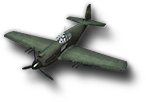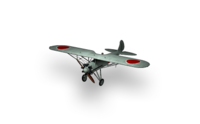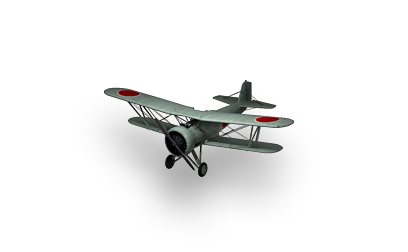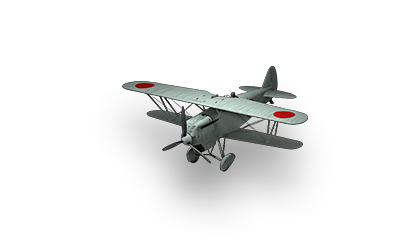Nakajima Type-91
The Nakajima Type-91 is a tier I Japanese fighter. It was built as a prototype to a request from the army, and it first flew in 1931. It became obsolete in 1936 with the coming of the Kawasaki Army Type 95 Fighter. 420 planes were built from 1931-1934.
Type-91
| Precio |
| 60 Supervivencia |
| 1540 kgPeso |
| 35.7 Daño |
| 783.2 Velocidad en vuelo |
| 260 km/hVel. máx. a nivel del mar |
| 260 km/hVel. máx. a la mejor altura |
| 500 mAltitud óptima |
| 440 km/hVelocidad máxima en picado |
| 40.9 m/sTasa de ascenso |
| 80 km/hVelocidad de pérdida |
| 210 km/hVelocidad en vuelo óptima |
| 86.1 Controlabilidad |
| 8.6 sTiempo medio en girar 360 gra |
| 110 °/sRégimen de alabeo |
| 1482.5 Maniobrabilidad |

Tech Tree
 I
I| Especificaciones: | |
| Potencia del motor, cv | |
| Tipo | |
| Peso, kg | |
| Precio: | |
| Coste de desarrollo | |
| Precio de compra | |
 I
I I
I| Especificaciones: | |
| Potencia del motor, cv | |
| Tipo | |
| Peso, kg | |
 I
I II
II| Especificaciones: | |
| Potencia del motor, cv | |
| Tipo | |
| Peso, kg | |
| Precio: | |
| Coste de desarrollo | |
| Precio de compra | |
 II
II II
II| Especificaciones: | |
| Potencia del motor, cv | |
| Tipo | |
| Peso, kg | |
 II
II I
I| Especificaciones: | |
| Supervivencia | |
| Peso, kg | |
 I
I I
I| Especificaciones: | |
| Supervivencia | |
| Peso, kg | |
| Precio: | |
| Coste de desarrollo | |
| Precio de compra | |
 I
I I
I| Especificaciones: | |
| Supervivencia | |
| Peso, kg | |
 I
I
 II
II| Especificaciones: | |
| Radio de daño, m | |
| Daño | |
| Peso, kg | |
| Precio: | |
| Coste de desarrollo | |
| Precio de compra | |
 II
II II
II| Especificaciones: | |
| Radio de daño, m | |
| Daño | |
| Peso, kg | |
| Precio: | |
| Precio de compra | |
 II
II I
I| Especificaciones: | |
| Calibre | |
| Velocidad de salida, m/s | |
| Daño | |
| Tasa de fuego, disparos/min | |
| Peso, kg | |
 I
I II
II| Especificaciones: | |
| Calibre | |
| Velocidad de salida, m/s | |
| Daño | |
| Tasa de fuego, disparos/min | |
| Peso, kg | |
| Precio: | |
| Coste de desarrollo | |
| Precio de compra | |
 II
II II
II| Especificaciones: | |
| Calibre | |
| Velocidad de salida, m/s | |
| Daño | |
| Tasa de fuego, disparos/min | |
| Peso, kg | |
| Precio: | |
| Precio de compra | |
 II
II


Modules

Motor
| Nivel | Motor | Potencia del motor, cv / Empuje | Tipo | Peso, kg | Precio, |
|---|---|---|---|---|---|
| I | Jupiter VIIF.P | 520 | enfriado por aire | 330 | 1550 |
| I | Jupiter VI | 450 | enfriado por aire | 330 | 0 |
| II | Kotobuki 2 | 580 | enfriado por aire | 350 | 2200 |

Armazón del avión
| Nivel | Armazón del avión | Supervivencia | Peso, kg | Precio, |
|---|---|---|---|---|
| I | 70 | 1150 | 1200 | |
| I | Nakajima Type 91 | 70 | 1150 | 1200 |

Arma externa
| Nivel | Bombas | Radio de daño, m | Daño | Peso, kg | Precio, |
|---|---|---|---|---|---|
| II | 35 | 800 | 30 | 200 |

Ametralladora sincronizada
| Nivel | Ametralladora | Calibre | Velocidad de salida, m/s | Daño | Tasa de fuego, disparos/min | Peso, kg | Precio, |
|---|---|---|---|---|---|---|---|
| I | 7.7 mm Vickers-J (S) | 7.7 | 960 | 17 | 600 | 30 | 0 |
| II | 7.7 mm Type 89 (S) | 7.7 | 960 | 19 | 700 | 30 | 1000 |

Compatible Equipment
Compatible Consumables
Player Opinion
Pros and Cons
Pros:
- Almost all LTH pretty average: speed and agility is slightly worse than the American counterpart, but better weapons.
- The best indicator of the speed of the roll, an order of magnitude better than other start aircraft - 111 degrees per second.
Cons:
- The lowest rate of HP strength. At 50 hitpoints, the Type-91 has the lowest health pool of all planes in WoWp. It is thus hig
Performance
The Type-91 has good maneuverability, even better than the Soviet I-5, making it the most maneuverable of all tier I planes. It's speed is also very good for tier Is, only coming second after the American P-12
Pretty fast and maneuverable aircraft, with good speed roll that allows you to quickly turn the barrels and other complex shapes. That provides greater potential in a dogfight as dodging enemy fire and attack from the front, followed by entering the tail and counterattack. In many respects, the aircraft still quite low, knocked out, only a small number of strength, only 60 units, so the game on this unit must be careful, as in the following on any Japanese plane. Use maneuvers, do not go to frontal attacks, or in the first row, and then you will succeed.
Historical Info
The Army ordered the new aircraft as the Nakajima Army Type 91 Fighter and the first deliveries took place late in 1931. However, issues arose with both directional stability and centre of gravity, with the result that the type was delayed entering service.
Between 1931 and 1934, 420 aircraft were constructed (including 100 by Ishikawajima; 23 of the total were Type 91-2, powered by a 432 kW (580 hp) Nakajima Kotobuki 2 radial engine. This version first flew in July 1934.
The Type 91 was supplanted in service by the Kawasaki Army Type 95 Fighter in 1936-7.
| Fighters | IINakajima A4N • IIKawasaki Ki-10 • IIKawasaki Ki-5 • IINakajima Ki-8 • IIIMitsubishi A5M • IIIMitsubishi Ki-18 • IIINakajima Ki-27 • IIIMitsubishi Ki-33 • IVMitsubishi A6M1 Zero • IVNakajima Ki-43-I Hayabusa • VMitsubishi A6M2 Zero • VMitsubishi A6M3 (experimental) • VNakajima Ki-43-II Hayabusa • VIMitsubishi A6M5 Zero • VIKawasaki Ki-61 Hien • VIKawasaki Ki-88 • VIIMitsubishi A7M Reppu • VIINakajima Ki-84 Hayate • VIIIMitsubishi J8M Shusui • VIIITachikawa Ki-94-II • IXTachikawa Ki-162-I • XTachikawa Ki-162-III |
| Heavy Fighters | VKawasaki Ki-45 Toryu • VIKawasaki Ki-102 • VIIRikugun Ki-93 • VIITachikawa Ki-94-I |
| Attack Aircraft |


